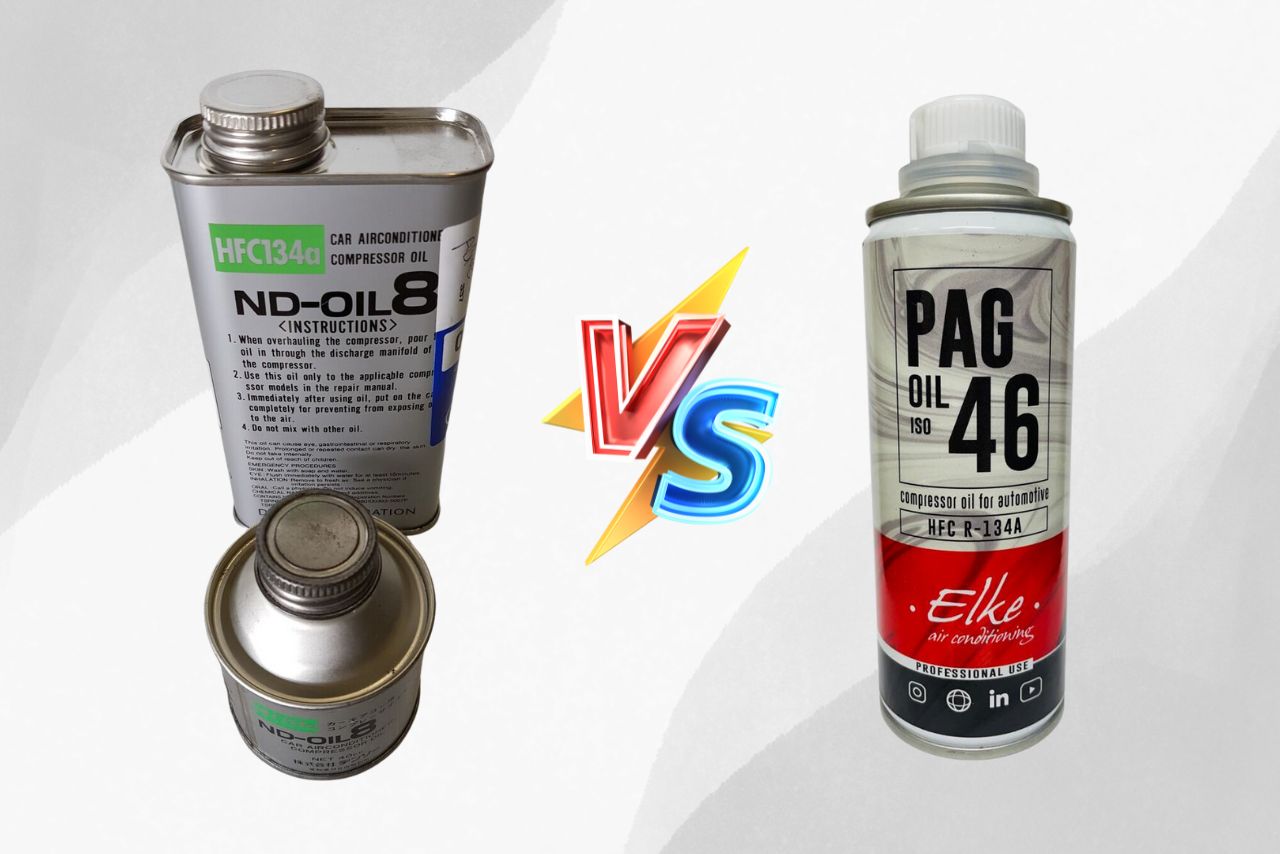Is ND8 Oil the Same as PAG 46? The Answer Is Yes, ND8 oil and PAG 46 oil are essentially the same thing. ND8 is a proprietary name for PAG 46 oil produced by Denso. Both oils are synthetic polyalkylene glycol (PAG) oils that are used in automotive air conditioning systems with R134a refrigerant.
ND8 and PAG 46 are fundamentally synonymous. Any PAG46 from different manufacturers will suffice, as they all adhere to the minimum specifications. PAG stands for Polyalkylene Glycol, with ’46’ indicating the viscosity level.
PAG stands for Polyalkylene Glycol, which serves as the base material for these oils. The number ’46’ denotes its viscosity level – a measure of how thick or thin an oil flows at certain temperatures.
It’s important to note that while ND8 and PAG 46 may come from different manufacturers, any variation within this category will meet the minimum specifications required.
Table of contents
Nd Oil 8 vs Pag 46:
| Image | Title | Brand | Prime | Buy |
|---|---|---|---|---|
| FJC 2501 PAG Oil – 128 fl. oz. | FJC | Prime | Buy Now | |
| TSI Supercool A/C Comp PAG Lube, 8 Oz, Flash Point 450 F | TSI Supercool | PrimeEligible | Buy Now |
Prices and images pulled from the Amazon Product Advertising API on:
ND oil 8 and PAG 46 are essentially the same thing. ND oil 8 is a proprietary name for PAG 46 oil produced by Denso. Both oils are synthetic polyalkylene glycol (PAG) oils that are used in automotive air conditioning systems with R134a refrigerant.
There are some minor differences between the two oils. ND oil 8 is said to have better low-temperature performance and to be more resistant to oxidation. However, these differences are likely to be negligible in most cases.
Overall, there is no real difference between ND oil 8 and PAG 46. You can use either oil in your vehicle without any problems.
If you are unsure which oil to use, it is always best to consult your owner’s manual.
Is ND8 Oil the Same as PAG 46?
When it comes to automotive lubricants, there are various types available in the market. Two commonly used ones are ND8 oil and PAG 46. While they may seem different at first glance, they actually share many similarities.
Let’s take a closer look:
To summarize, while ND8 oil is specifically labeled as such for use in refrigeration systems, any brand offering PAG 46 will fulfill the necessary requirements due to their synonymity and adherence to minimum specifications.
Understanding these similarities allows you to confidently choose between ND8 oil or any other reputable brand offering PAG 46 based on availability or personal preference.
| Synonymy | Fundamental similarity |
| Specs | All adhere to requirements |
| Composition | Both are polyalkylene glycols |
| Viscosity Level | Indicated by numbers |
Remember that proper maintenance and regular oil changes are essential for optimal performance and longevity of your equipment.
Always consult the manufacturer’s guidelines or seek professional advice to ensure you select the most suitable lubricant for your specific application.
The Fundamentals of ND8 and PAG 46:
To summarize:
- ND8 oil can be considered interchangeable with PAG 46.
- Different manufacturers’ versions of PAG 46 will work effectively.
- The number ’46’ denotes the appropriate viscosity level for compatible use in automotive systems.
Choosing Any PAG46 from Different Manufacturers:

When it comes to selecting a PAG46 oil, you’ll be glad to know that options are available from various manufacturers. Here’s what you need to consider when choosing any PAG46 oil:
Remember, regardless of the manufacturer, all PAG46 oils share fundamental similarities due to their adherence to industry standards and specifications set for Polyalkylene Glycol-based lubricants.
Watch this video for more detail:
What Does PAG Stand For?
- PAG stands for Polyalkylene Glycol.
- ’46’ indicates the viscosity level of the oil.
PAG is an acronym that stands for Polyalkylene Glycol. It is a type of synthetic lubricant commonly used in automotive air conditioning systems and some industrial applications.
The number following “PAG” represents the viscosity level of the oil, indicating its flow characteristics and resistance to shear.
Here are some key points about PAG:
In summary, PAG stands for Polyalkylene Glycol, with ’46’ representing its medium-viscosity grade commonly used in automotive air conditioning systems. Understanding what PAG stands for helps identify its role as a crucial component in maintaining optimal performance within these systems.
Decoding the Viscosity Level of ’46’ in PAG 46:

In the world of automotive lubricants, numbers often hold great significance. When it comes to PAG 46 oil, the number ’46’ specifically refers to its viscosity level.
Let’s dive deeper into decoding this numerical value and understand what it means for your vehicle’s performance.
Here are a few key points to consider:
By selecting an appropriate viscosity grade like PAG 46 for your specific application needs, you ensure optimal lubrication under varying operating conditions while maintaining system efficiency.
Remember that when working with automotive oils or refrigeration lubricants such as ND8 or PAG 46, always consult your vehicle manufacturer’s recommendations or professional advice before making any decisions.
Can I Use Pag 46 Instead of Pag 100?
Yes, you can use PAG 46 instead of PAG 100 in most cases. PAG 46 is a thinner oil than PAG 100, so it will flow more easily at low temperatures and provide better lubrication during cold starts.
However, PAG 100 is a thicker oil, so it will provide better protection at high temperatures.
If you live in a cold climate or frequently drive in stop-and-go traffic, then PAG 46 is a good choice. If you live in a hot climate or frequently tow or haul heavy loads, then PAG 100 may be a better choice.
It is important to consult your owner’s manual to see which type of PAG oil is recommended for your vehicle. If you are unsure, it is always best to err on the side of caution and use the type of oil that is specifically recommended by the manufacturer.
Note: It is not recommended to mix different types of PAG oil. If you are switching from PAG 100 to PAG 46, it is important to completely flush the system of the old oil before adding the new oil.
Conclusion and final thoughts 💭
It is clear that ND8 oil and PAG 46 are essentially the same when it comes to their fundamental properties. Both types of oil adhere to the minimum specifications required for automotive applications.
PAG 46, which stands for Polyalkylene Glycol with a viscosity level of ’46’, is widely used in various systems where this viscosity grade is necessary.
It’s important to note that any PAG46 oil from different manufacturers will suffice for your needs.
The key takeaway here is that regardless of the brand or manufacturer, as long as you use a PAG46 oil, you can expect it to perform at an acceptable level.





Leave a Reply